PEP小学英语小升初语法
小升初英语必背短语(知识清单)-人教PEP版英语六年级下册
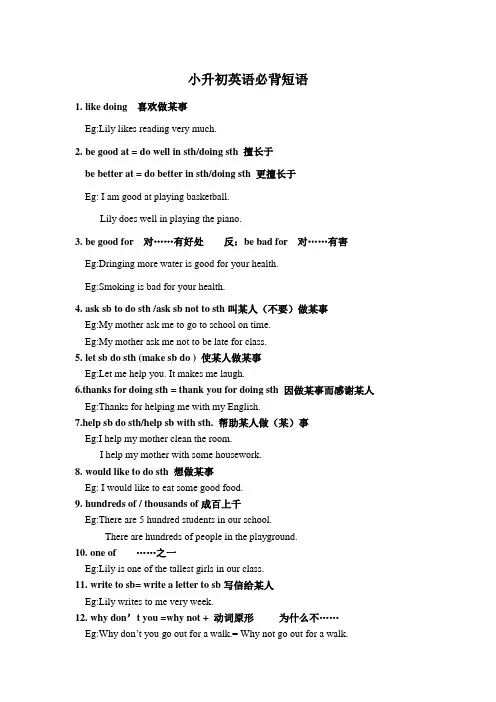
小升初英语必背短语1.like doing 喜欢做某事Eg:Lily likes reading very much.2.be good at = do well in sth/doing sth 擅长于be better at = do better in sth/doing sth 更擅长于Eg: I am good at playing basketball.Lily does well in playing the piano.3.be good for 对……有好处反:be bad for 对……有害Eg:Dringing more water is good for your health.Eg:Smoking is bad for your health.4.ask sb to do sth /ask sb not to sth叫某人(不要)做某事Eg:My mother ask me to go to school on time.Eg:My mother ask me not to be late for class.5.let sb do sth (make sb do ) 使某人做某事Eg:Let me help you. It makes me laugh.6.thanks for doing sth = thank you for doing sth 因做某事而感谢某人Eg:Thanks for helping me with my English.7.help sb do sth/help sb with sth. 帮助某人做(某)事Eg:I help my mother clean the room.I help my mother with some housework.8.would like to do sth 想做某事Eg: I would like to eat some good food.9.hundreds of / thousands of成百上千Eg:There are 5 hundred students in our school.There are hundreds of people in the playground.10.one of ……之一Eg:Lily is one of the tallest girls in our class.11.write to sb= write a letter to sb写信给某人Eg:Lily writes to me very week.12.why don’t you =why not + 动词原形为什么不……Eg:Why don’t you go out for a walk.= Why not go out for a walk.13.something important 一些重要的事情不定代词+形容词14.it’s time to do sth= it’s time for sth.是时候做某事了Eg:It’s time to have lunch.= It’s time for lunch.15.be like问性格,look like 问外貌be like 范围更大一些,有时候既问性格也问外貌Eg:What's your sister like? 你姐姐怎么样?/你姐姐是怎样一个人?She is kind. 她很善良。
PEP小升初语法、常用句型总复习
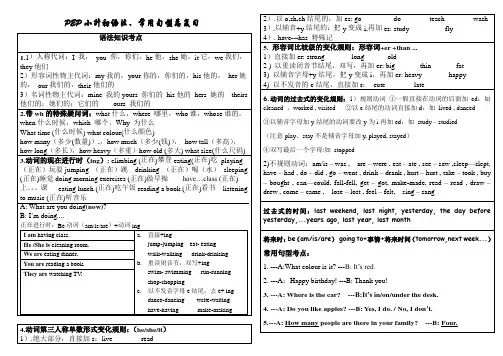
15.--- A:Whose coat is this? ---B:It’s mine.
16.--- A:Who’s your art teacher?(你的美术老师是谁?)---B: Mr Jones.
---B:Sure.Here you are.(当然可以,给你。)
22.---A:What can you do for the party, children?(孩子们,你们能为联欢会做什么?)
----B:I cansing English songs. (我会唱英文歌。)
23.---A: Can you do any kung fu, John? (约翰,你会武术吗?)
---A: I’m angry. What should I do?
---B:You should take a deep breath.
36.---A: How tall are you?你有多高?
--- B:I’m 1.65 metres.我1.65米高。
37. ---A: How heavy are you?你有多重?
3.动词的现在进行时(ing):climbing (正在)攀登eating(正在)吃playing(正在)玩耍jumping(正在)跳drinking(正在)喝(水)sleeping (正在)睡觉doing morning exercises (正在)做早操have…class (正在)上。。。课eating lunch (正在)吃午饭reading a book (正在)看书listening to music (正在)听音乐
小升初英语语法现在进行时(讲义)人教PEP版英语六年级下册
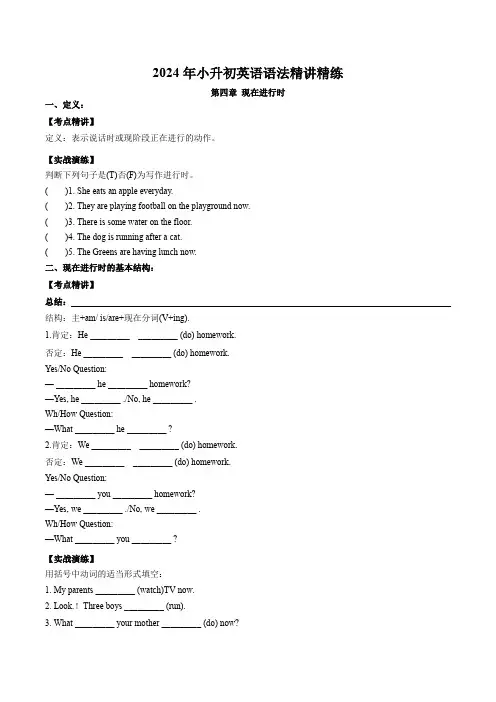
2024年小升初英语语法精讲精练第四章现在进行时一、定义:【考点精讲】定义:表示说话时或现阶段正在进行的动作。
【实战演练】判断下列句子是(T)否(F)为写作进行时。
( )1. She eats an apple everyday.( )2. They are playing football on the playground now.( )3. There is some water on the floor.( )4. The dog is running after a cat.( )5. The Greens are having lunch now.二、现在进行时的基本结构:【考点精讲】总结:结构:主+am/ is/are+现在分词(V+ing).1.肯定:He _________ _________ (do) homework.否定:He _________ _________ (do) homework.Yes/No Question:— _________ he _________ homework?—Yes, he _________ ./No, he _________ .Wh/How Question:—What _________ he _________ ?2.肯定:We _________ _________ (do) homework.否定:We _________ _________ (do) homework.Yes/No Question:— _________ you _________ homework?—Yes, we _________ ./No, we _________ .Wh/How Question:—What _________ you _________ ?【实战演练】用括号中动词的适当形式填空:1.My parents _________ (watch)TV now.2.Look.!Three boys _________ (run).3.What _________ your mother _________ (do) now?4. _________ your dog _________ now?(sleep)5. _________ you _________ (listen) to music?Yes,I am.三、词形变化(现在分词):【考点精讲】总结:⑴ 直接+ing watching looking⑴ 去e+ing giving making ing⑴ 双写最后一个字母+ing sitting putting running⑴ 以ie结尾变ie为y加ing lielying diedying tietying【实战演练】写出下列动词的现在分词go _________ listen _________ play _________ e _________ sing _________ have _________ write _________ dance _________ sit _________ read _________ 四、现在进行时的基本用法【考点精讲】⑴ 表示说话时正在进行的动作,常和now, look, listen 连用。
PEP英语小升初知识点归纳
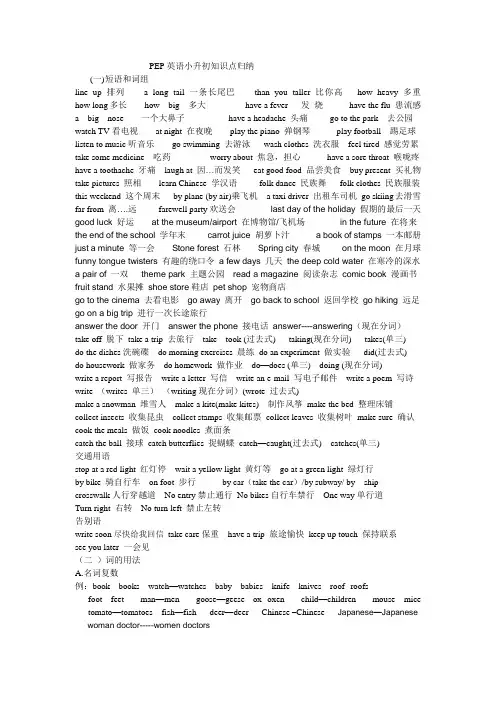
PEP英语小升初知识点归纳(一)短语和词组line up 排列 a long tail 一条长尾巴than you taller 比你高how heavy 多重how long多长how big 多大have a fever 发烧have the flu 患流感a big nose 一个大鼻子have a headache 头痛go to the park 去公园watch TV看电视at night 在夜晚play the piano 弹钢琴play football 踢足球listen to music听音乐go swimming 去游泳wash clothes 洗衣服feel tired 感觉劳累take some medicine 吃药worry about 焦急,担心have a sore throat 喉咙疼have a toothache 牙痛laugh at 因…而发笑eat good food 品尝美食buy present 买礼物take pictures 照相learn Chinese 学汉语folk dance 民族舞folk clothes 民族服装this weekend 这个周末by plane (by air)乘飞机 a taxi driver 出租车司机go skiing去滑雪far from 离….远farewell party欢送会last day of the holiday 假期的最后一天good luck 好运at the museum/airport 在博物馆/飞机场in the future 在将来the end of the school 学年末carrot juice 胡萝卜汁 a book of stamps 一本邮册just a minute 等一会Stone forest 石林Spring city 春城on the moon 在月球funny tongue twisters 有趣的绕口令a few days 几天the deep cold water 在寒冷的深水a pair of 一双theme park 主题公园read a magazine 阅读杂志comic book 漫画书fruit stand 水果摊shoe store鞋店pet shop 宠物商店go to the cinema 去看电影go away 离开go back to school 返回学校go hiking 远足go on a big trip 进行一次长途旅行answer the door 开门answer the phone 接电话answer----answering(现在分词)take off 脱下take a trip 去旅行take---took (过去式) taking(现在分词) takes(单三)do the dishes洗碗碟do morning exercises 晨练do an experiment 做实验did(过去式)do housework 做家务do homework 做作业do—does (单三) doing (现在分词)write a report 写报告write a letter 写信write an e-mail 写电子邮件write a poem 写诗write (writes 单三)(writing现在分词)(wrote 过去式)make a snowman 堆雪人make a kite(make kites) 制作风筝make the bed 整理床铺collect insects 收集昆虫collect stamps 收集邮票collect leaves 收集树叶make sure 确认cook the meals 做饭cook noodles 煮面条catch the ball 接球catch butterflies 捉蝴蝶catch—caught(过去式) catches(单三)交通用语stop at a red light 红灯停wait a yellow light 黄灯等go at a green light 绿灯行by bike 骑自行车on foot 步行by car(take the car)/by subway/ by ship crosswalk人行穿越道No entry禁止通行No bikes自行车禁行One way单行道Turn right 右转No turn left 禁止左转告别语write soon尽快给我回信take care保重have a trip 旅途愉快keep up touch 保持联系see you later 一会见(二)词的用法A.名词复数例:book---books watch—watches baby---babies knife---knives roof--roofs foot---feet man—men goose—geese ox--oxen child—children mouse---mice tomato—tomatoes fish—fish deer—deer Chinese –Chinese Japanese—Japanese woman doctor-----women doctorsB.冠词例:a worker a pen an hour an apple an orange the pictureC.代词例:I(主格)---me(宾格)my(形容词物主代词)-----mine(名词性物主代词) You ----you your ---- yoursHe -----him his ------ hisShe ----her her ------hersWe ---us our ------oursYou ---you your ------yoursThey -- them their -------theirs(注:This is my jacket.(同义句) This jacket is mine.D.数词.基数词one two three four …..序数词first second third fourth fifth eighth ninth twentieth thirty—first(第三十一)F.形容词比较级和最高级例:tall—taller big---bigger heavy—heavier late—later beautiful—more beautiful good/well---better---best(最高级) many/much---more---most(最高级)ill/bad----worse-----worst(最高级) little-------less---------least(最高级)old---older/elder—oldest/eldest(最高级) far—farther/further—farthest/furthest(最高级) 例句:I am taller than your brother. He is shorter than me.(三)英语时态的简单用法A..一般现在时(当主语是单数第三人称时,谓语动词要发生相应的变化,即单三形式)(always usually often sometimes never every day …..这些词出现体现一般现在时)例1.)He always helps others. 他总是帮助别人。
PEP小学英语小升初必考知识点归纳
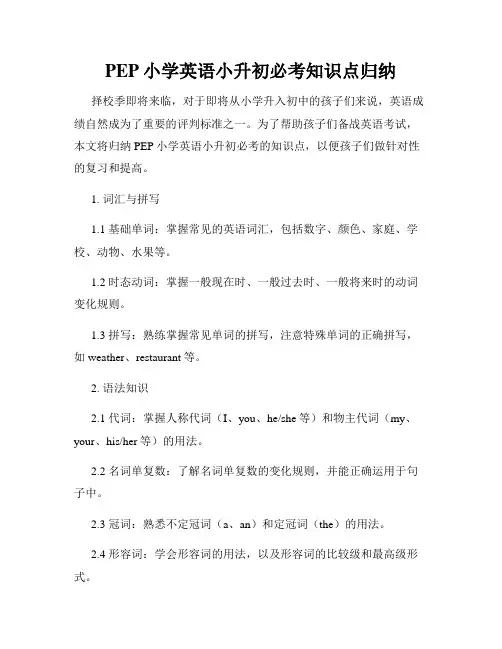
PEP小学英语小升初必考知识点归纳择校季即将来临,对于即将从小学升入初中的孩子们来说,英语成绩自然成为了重要的评判标准之一。
为了帮助孩子们备战英语考试,本文将归纳PEP小学英语小升初必考的知识点,以便孩子们做针对性的复习和提高。
1. 词汇与拼写1.1 基础单词:掌握常见的英语词汇,包括数字、颜色、家庭、学校、动物、水果等。
1.2 时态动词:掌握一般现在时、一般过去时、一般将来时的动词变化规则。
1.3 拼写:熟练掌握常见单词的拼写,注意特殊单词的正确拼写,如weather、restaurant等。
2. 语法知识2.1 代词:掌握人称代词(I、you、he/she等)和物主代词(my、your、his/her等)的用法。
2.2 名词单复数:了解名词单复数的变化规则,并能正确运用于句子中。
2.3 冠词:熟悉不定冠词(a、an)和定冠词(the)的用法。
2.4 形容词:学会形容词的用法,以及形容词的比较级和最高级形式。
2.5 介词:掌握常用介词的用法,如in、on、at等。
2.6 动词词组:掌握一些常用的动词词组,如look after、take care of 等。
3. 句型与表达3.1 Be动词句型:掌握“主语+be动词+形容词/名词”句型的用法,如I am happy、He is a teacher等。
3.2 疑问句:学会用be动词和助动词构成疑问句,如Are you a student?、Can you swim?等。
3.3 祈使句:了解祈使句的基本结构,如Wash your hands before eating.等。
3.4 感叹句:了解感叹句的表达方式,如How beautiful!、What anice day!等。
3.5 日常交际用语:熟练掌握日常用语,如问候语、道谢、道歉等。
4. 阅读理解4.1 短文阅读:学会从短文中获取信息,并正确回答问题。
4.2 图片阅读:学会看图并理解其含义,回答相关问题。
小升初英语语法介词(讲义)人教PEP版英语六年级下册
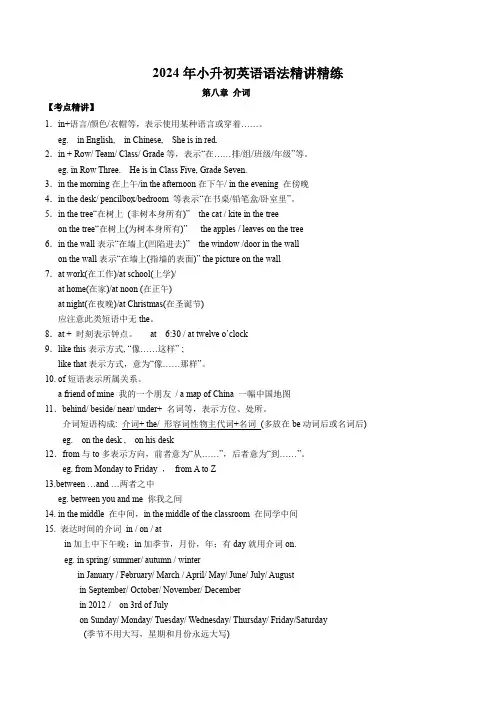
2024年小升初英语语法精讲精练第八章介词【考点精讲】1.in+语言/颜色/衣帽等,表示使用某种语言或穿着……。
eg. in English, in Chinese, She is in red.2.in + Row/ Team/ Class/ Grade等,表示“在……排/组/班级/年级”等。
eg. in Row Three. He is in Class Five, Grade Seven.3.in the morning在上午/in the afternoon在下午/ in the evening 在傍晚4.in the desk/ pencilbox/bedroom 等表示“在书桌/铅笔盒/卧室里”。
5.in the tree“在树上(非树本身所有)” the cat / kite in the treeon the tree“在树上(为树本身所有)” the apples / leaves on the tree6.in the wall表示“在墙上(凹陷进去)” the window /door in the wallon the wall表示“在墙上(指墙的表面)” the picture on the wall7.at work(在工作)/at school(上学)/at home(在家)/at noon (在正午)at night(在夜晚)/at Christmas(在圣诞节)应注意此类短语中无the。
8.at + 时刻表示钟点。
at 6:30 / at twelve o’clock9.like this表示方式, “像……这样” ;like that表示方式,意为“像……那样”。
10. of短语表示所属关系。
a friend of mine 我的一个朋友/ a map of China 一幅中国地图11.behind/ beside/ near/ under+ 名词等,表示方位、处所。
人教版(PEP)小学英语小升初时态课件
四、一般过去时 一般过去时表示过去某个时间产生的动作或存在 的状态。 (一)时间状语:last year/week,yesterday,just now
(二)结构 1.肯定句:主语+was/were+其他. I was ill yesterday.昨天我生病了。 否定句:主语+was/were+not+其他. I wasn’t ill yesterday.昨天我没有生病。 一般疑问句:Was/Were+主语+其他?
当主语是第三人称单数时: ①肯定句:主语+动词第三人称单数+其他. She cleans the room every day. 她每天打扫房间。 ②否定句:主语+助动词(doesn’t)+动词原形+其他. She doesn’t clean the room every day. 她不是每天打扫房间。
二、一般现在时 一般现在时是表示经常产生的动作、存在的状态 或习惯性的动作的时态。常用的时间状语有:often, sometimes,usually,in the morning/afternoon/evening, every week/day/year等。
(一)构成 1.表示目前的状态,谓语动词用be动词。 肯定句:主语+be动词+其他.
时态
一、现在进行时 现在进行时表示现在正在进行或产生的动作。 (一)结构:be(am,is,are)动词+现在分词(动词-ing情 势) (二)现在进行时的标志词有now,look,listen等。 I’m playing football now. 我现在正在踢足球。
Look!The girl is reading a book. 看!那个女孩正在看书。 Listen!The bird is singing. 听!小鸟正在唱歌。
PEP小学英语小升初必考知识点归纳
P E P小学英语小升初必考知识点归纳-CAL-FENGHAI.-(YICAI)-Company One1PEP小学英语小升初知识点归纳一:学生易错词汇1. a, an的选择: 元音字母开头的单词用an,辅音字母开头的单词用a.2. am , is , are的选择: 单数用is , 复数用are. I 用 am , you 用 are.3. have , has 的选择: 表示某人有某物。
单数用has , 复数用have. I , you 用 have .4. there is, there are 的选择:表示某地有某物,某人。
单数用there is , 复数用there are.5. some, any 的选择:肯定句用some, 疑问句和否定句用any.6. 疑问词的选择:what (什么) who (谁) where (哪里) whose (谁的) why(为什么)when(什么时候)which(哪一个)how old (多大) how many (多少)how much(多少钱)二:形容词比较级详解当我们需要对事物作出比较时,需要用到比较级。
比较级的句子结构通常是:什么 + 动词be (am , is , are ) + 形容词比较级 + than(比)+ 什么 ,如:I’m taller and heavier than you. (我比你更高和更重。
)An elephant is bigger than a tiger. (一只大象比一只老虎更大。
)形容词的比较级是在形容词的基础上变化而来的,它的变化规则是:① 一般的直接在词尾加er ,如 tall - taller , strong - stronger ,② 以e结尾的,直接加r ,如 fine – finer ,③ 以辅音字母加y结尾的,先改y为i再加er,如funny - funnier④ 双写最后的字母再加er,如big – bigger, thin – thinner ,hot – hotter☆注意比较的两者应该是互相对应的可比较的东西。
PEP小学英语小升初必考知识点归纳
PEP小学英语小升初知识点归纳一:学生易错词汇1. a, an的选择: 元音字母开头的单词用an,辅音字母开头的单词用a.2. am , is , are的选择: 单数用is , 复数用are. I 用am , you 用are.3. have , has 的选择: 表示某人有某物。
单数用has , 复数用have. I , you 用have .4. there is, there are 的选择:表示某地有某物,某人。
单数用there is , 复数用there are.5. some, any 的选择:肯定句用some, 疑问句和否定句用any.6. 疑问词的选择:what (什么) who (谁) where (哪里) whose (谁的) why(为什么)when(什么时候)which(哪一个)how old (多大) how many (多少)how much(多少钱)二:形容词比较级详解当我们需要对事物作出比较时,需要用到比较级。
比较级的句子结构通常是:什么+ 动词be (am , is , are ) + 形容词比较级+ than(比)+ 什么,如:I’m taller and heavier than you. (我比你更高和更重。
)An elephant is bigger than a tiger. (一只大象比一只老虎更大。
)形容词的比较级是在形容词的基础上变化而来的,它的变化规则是:①一般的直接在词尾加er ,如tall - taller , strong - stronger ,②以e结尾的,直接加r ,如fine – finer ,③以辅音字母加y结尾的,先改y为i再加er,如funny - funnier④双写最后的字母再加er,如big – bigger, thin – thinner ,hot – hotter☆注意比较的两者应该是互相对应的可比较的东西。
典型错误:My hair is longer than you.(我的头发比你更长。
六年级小升初英语知识点pep
六年级小升初英语知识点pep 六年级小升初英语考试是许多学生和家长关注的焦点。
为了帮助同学们更好地备考,本文将介绍六年级英语中的一些重要知识点。
以下按照不同的语法和词汇分类来详细介绍,以便于大家更好地理解和记忆。
名词:名词是指人、事物或概念的名称。
在英语中,名词通常有单数和复数两种形式。
复数形式一般在名词后面加-s或-es,但也有一些特殊情况需要记忆。
例如:- 单数名词后面加-s构成复数形式:book-books, pen-pens, dog-dogs等。
- 单数名词后面加-es构成复数形式:box-boxes, watch-watches, brush-brushes等。
- 以y结尾的单词,去y加-ies构成复数形式:baby-babies,party-parties, candy-candies等。
- 以f或fe结尾的名词,变f或fe为v,再加-es构成复数形式:leaf-leaves, knife-knives, thief-thieves等。
动词:动词是指表示行为或状态的词语。
根据时态和语态的不同,动词的形式和用法也会有所不同。
- 一般现在时:用于描述经常发生的动作、现在的状态或真理。
例如:I go to school every day.(我每天去学校。
)- 现在进行时:用于表示现在正在进行的动作。
现在进行时的动词由be动词(am, is, are)和动词的现在分词构成。
例如:He is playing basketball now.(他正在打篮球。
)- 一般过去时:用于过去某个时间发生的动作。
一般过去时的动词通常是在动词原形后面加-ed构成。
例如:We visited the museum yesterday.(昨天我们参观了博物馆。
)- 一般将来时:用于表示将来要发生的动作或事件。
一般将来时的动词前面要加助动词will。
例如:I will study harder next year.(明年我将更加努力学习。
- 1、下载文档前请自行甄别文档内容的完整性,平台不提供额外的编辑、内容补充、找答案等附加服务。
- 2、"仅部分预览"的文档,不可在线预览部分如存在完整性等问题,可反馈申请退款(可完整预览的文档不适用该条件!)。
- 3、如文档侵犯您的权益,请联系客服反馈,我们会尽快为您处理(人工客服工作时间:9:00-18:30)。
实用文档文案大全PEP小学英语毕业总复习一:学生易错词汇1. a, an的选择: 元音字母开头的单词用an,辅音字母开头的单词用a.2. am , is , are的选择: 单数用is , 复数用are. I 用am , you 用 are.3. have , has 的选择: 表示某人有某物。
单数用has , 复数用have. I ,you 用 have .4. there is, there are 的选择:表示某地有某物,某人。
单数用there is , 复数用there are.5. some, any 的选择:肯定句用some, 疑问句和否定句用any.6. 疑问词的选择:what (什么) who (谁) where (哪里) whose (谁的) why(为什么)when(什么时候)which (哪一个)how old (多大) how many (多少)how much (多少钱)二:形容词比较级详解当我们需要对事物作出比较时,需要用到比较级。
比较级的句子结构通常是:什么 + 动词be (am , is , are ) + 形容词比较级 + than (比)+ 什么 ,如:I'm taller and heavier than you. (我比你更高和更重。
)An elephant is bigger than a tiger. (一只大象比一只老虎更大。
)形容词的比较级是在形容词的基础上变化而来的,它的变化规则是:①一般的直接在词尾加er ,如 tall - taller , strong - stronger ,②以e结尾的,直接加r ,如 fine – finer ,③以辅音字母加y结尾的,先改y为i再加er,如funny - funnier ④双写最后的字母再加er,如big – bigger, thin – thinner ,hot – hotter ☆注意☆比较的两者应该是互相对应的可比较的东西。
典型错误:My hair is longer than you.(我的头发比你更长。
)比较的两者是我的头发、你(整个人),那么比较的对象就没有可比性。
应该改为:My hair is longer than yours. 或My hair is longer than your hair.比较级专项练习: 一、从方框中选出合适的单词完成句子heavy tall long big(1) How is the Yellow River?(2) How is Mr Green? He's175cm.(3) How are your feet? I wearsize 18. (4)How is the fish?It's 2kg.二、根据句意写出所缺的单词(1) I'm 12 years old. You're 14. I'mthan you. (2) A rabbit's tail isthan a monkey's tail.(3) An elephant isthan a pig. (4) A lake isthan a sea.(5) A basketball is thana football.实用文档文案大全三、根据中文完成句子.(1) 我比我的弟弟大三岁. I'mthan my brother.(2) 这棵树要比那棵树高. This treethan that one. (3) 你比他矮四厘米.You are than he.(4) 谁比你重?than you?四、根据答句写出问句(1)I'm 160 cm.(2)I'm 12 years old.(4)Amy's hair is 30 cm long.四:动词现在分词详解动词的ing形式的构成规则:①一般的直接在后面加上ing , 如doing , going , working , singing , eating②以e 结尾的动词,要先去e再加ing,如having , writing③双写最后一个字母的(此类动词极少)有:running , swimming , sitting , getting五:人称和数六:句型专项归类1、肯定句:是指用肯定的语气来陈述的句子,如:I'm a student. She is a doctor.He works in a hospital.There are four fans in our classroom. He will eat lunch at 12:00. I watched TV yesterday evening.2、否定句:含有否定词或表示否定意义词的句子,如:I'm nota student. She is实用文档文案大全not (isn't) a doctor.He does not (doesn't) work in a hospital. There are not (aren't) four fans in our classroom. He will not (won't) eat lunch at 12:00. I did not (didn't) watch TV yesterday evening.☆注意☆小结:否定句主要是在肯定句的基础上加上了否定词“not”。
有动词be的句子则“not”加在be后面,可缩写成“isn't,aren't”,但am not 一般都分开写。
没有动词be的句子则要先在主要动词的前面加上一个助动词(do,does,did),然后在它后面加上“not”,你也可以把它们缩写在一起如“don't , doesn't , didn't )。
这三个助动词要根据人称和时态来选择,其中“does”只用于一般现在时主语是第三人称单数的情况,而“did”只用于一般过去时,不论主语是什么人称和数,都用“did”。
3、一般疑问句:是指询问事实的句子,此类句子必须用“yes”,或“no”来回答。
如:Are you a student? Yes, I am / No, I'm not.Is she a doctor? Yes, she is. / No, she is n't. Does he work in a hospital? Yes, he does. / No,he does n't.Are there four fans in our classroom? Yes, there are. / No, there are n't.Are you going to buy a comic book tonight? Yes, I am. / No, I am not. (Yes, we are. / No, we are n't.) Will he eat lunch at 12:00? Yes, I will. / No, I will not(won't).Are they swimming? Yes, they are. / No, they are n't. Did you watch TV yesterday evening? Yes, I did. / No, I did n't.☆注意☆小结:一般疑问句是在肯定句的基础上,①把动词be调到首位,其他照写,末尾标点符号变成问号即可。
②没有动词be的句子则要在句首加上一个助动词(do,does,did)再把紧跟在后面的动词变回原形,末尾标点符号变成问号即可。
这三个助动词也要根据人称和时态来选择,其中“does”只用于一般现在时主语是第三人称单数的情况,而“did”只用于一般过去时,不论主语是什么人称和数,都用“did”。
一般疑问句有个重要的原则就是问和答要一致,即问句里的第一个单词(助动词)和简略答句里的这个词是一致的。
4、特殊疑问句:以特殊疑问词(what , where , who , which , when , whose , why , how等)开头引导的句子。
此类句子应该问什么就答什么,不能用“yes 、no”来回答。
如:What is this? It's a computer.What does he do? He's a doctor.Where are you going? I'm going to Beijing. Who played football with you yesterday afternoon? Mike.Which season do you like best? Summer.When do you usually get up? I usually get up at 6:30.实用文档文案大全Whose skirt is this? It's Amy's.Why do you like spring best? Because I can plant trees.How are you? I'm fine. / I'm happy.How did you go to Xinjiang? I went to Xinjiang by train.☆其中how又可以和其他一些形容词连用组成特殊疑问词组用来提问,如: how many(多少(数量)), how much(多少(钱)), how tall(多高), how long(多长), how big (多大), how heavy(多重)例句:How many pencils do you have? I have three pencils.How many girls can you see? I can see four girls. How many desks are there in your classroom? There are 51.☆小结:how many 用来提问可数名词的数量,主要有以上三种句式搭配,How many + 名词复数 + do you have? 你有多少……?How many + 名词复数+ can you see? 你能看见多少……?How many + 名词复数+ are there…? 有多少……?七:完全、缩略形式: I'm=I am he's=he is she's=she is they're=they areyou're=you are there's=there is they're=they are can't=can not don't=do notdoesn't=does not isn't=is not aren't=are not let's=let us won't=will not I'll=I will wasn't=was not总结:通常情况下,'m即am,'s即is(但 let's=let us),'re即are ,n't即not (但can't=can not)八:与字母相关的题型 ( 注:五个元音字母是 Aa Ee Ii Oo Uu ) 一.将所给字母的大小写写在四线格上二.写出下列字母的左邻右舍。
